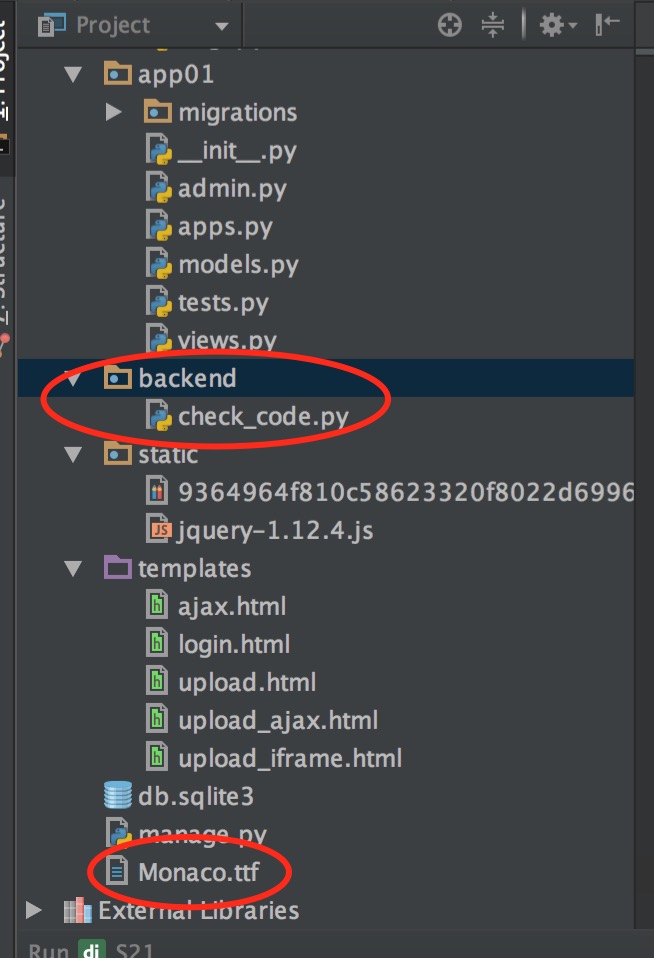Django中验证码的登录
2016-09-27 16:19
330 查看
需求概述
一般登录页面或者其他页面都需要验证码的功能,那在Django中如何实现呢?这基本就需要用到第三方模块了:
pillow
还需要两个文件,一个是字体文件:
Monaco.ttf,另一个是一个模块:
check_code.py,还有一个是导入io模块,我们先来看下
check_code.py的代码:
#!/usr/bin/env python #coding:utf-8 import random from PIL import Image, ImageDraw, ImageFont, ImageFilter _letter_cases = "abcdefghjkmnpqrstuvwxy" # 小写字母,去除可能干扰的i,l,o,z _upper_cases = _letter_cases.upper() # 大写字母 _numbers = ''.join(map(str, range(3, 10))) # 数字 init_chars = ''.join((_letter_cases, _upper_cases, _numbers)) def create_validate_code(size=(120, 30), chars=init_chars, img_type="GIF", mode="RGB", bg_color=(255, 255, 255), fg_color=(0, 0, 255), font_size=18, font_type="Monaco.ttf", length=4, draw_lines=True, n_line=(1, 2), draw_points=True, point_chance = 2): ''' @todo: 生成验证码图片 @param size: 图片的大小,格式(宽,高),默认为(120, 30) @param chars: 允许的字符集合,格式字符串 @param img_type: 图片保存的格式,默认为GIF,可选的为GIF,JPEG,TIFF,PNG @param mode: 图片模式,默认为RGB @param bg_color: 背景颜色,默认为白色 @param fg_color: 前景色,验证码字符颜色,默认为蓝色#0000FF @param font_size: 验证码字体大小 @param font_type: 验证码字体,默认为 ae_AlArabiya.ttf @param length: 验证码字符个数 @param draw_lines: 是否划干扰线 @param n_lines: 干扰线的条数范围,格式元组,默认为(1, 2),只有draw_lines为True时有效 @param draw_points: 是否画干扰点 @param point_chance: 干扰点出现的概率,大小范围[0, 100] @return: [0]: PIL Image实例 @return: [1]: 验证码图片中的字符串 ''' width, height = size # 宽, 高 img = Image.new(mode, size, bg_color) # 创建图形 draw = ImageDraw.Draw(img) # 创建画笔 def get_chars(): '''生成给定长度的字符串,返回列表格式''' return random.sample(chars, length) def create_lines(): '''绘制干扰线''' line_num = random.randint(*n_line) # 干扰线条数 for i in range(line_num): # 起始点 begin = (random.randint(0, size[0]), random.randint(0, size[1])) #结束点 end = (random.randint(0, size[0]), random.randint(0, size[1])) draw.line([begin, end], fill=(0, 0, 0)) def create_points(): '''绘制干扰点''' chance = min(100, max(0, int(point_chance))) # 大小限制在[0, 100] for w in range(width): for h in range(height): tmp = random.randint(0, 100) if tmp > 100 - chance: draw.point((w, h), fill=(0, 0, 0)) def create_strs(): '''绘制验证码字符''' c_chars = get_chars() strs = ' %s ' % ' '.join(c_chars) # 每个字符前后以空格隔开 font = ImageFont.truetype(font_type, font_size) font_width, font_height = font.getsize(strs) draw.text(((width - font_width) / 3, (height - font_height) / 3), strs, font=font, fill=fg_color) return ''.join(c_chars) if draw_lines: create_lines() if draw_points: create_points() strs = create_strs() # 图形扭曲参数 params = [1 - float(random.randint(1, 2)) / 100, 0, 0, 0, 1 - float(random.randint(1, 10)) / 100, float(random.randint(1, 2)) / 500, 0.001, float(random.randint(1, 2)) / 500 ] img = img.transform(size, Image.PERSPECTIVE, params) # 创建扭曲 img = img.filter(ImageFilter.EDGE_ENHANCE_MORE) # 滤镜,边界加强(阈值更大) return img, strs
这边有下载地址:点我点我
文件位置:

代码
HTML文件:<!DOCTYPE html>
<html lang="en">
<head>
<meta charset="UTF-8">
<title></title>
</head>
<body>
<form action="/login/" method="POST">
<input type="text" name="username" />
<input type="text" name="pwd" />
<input type="text" name="check_code" />
{# /* src为图片的后台地址 */#}
<img src="/check_code/" onclick="ChangeCode(this);">
<input type="submit" />
</form>
<script>
// 点击一次,更改图片内容,
function ChangeCode(ths){
ths.src = ths.src + '?';
}
</script>
</body>
</html>views.py文件:
def check_code(request):
import io
from backend import check_code as CheckCode
stream = io.BytesIO()
# img图片对象,code在图像中写的内容
img, code = CheckCode.create_validate_code()
img.save(stream, "png")
# 图片页面中显示,立即把session中的CheckCode更改为目前的随机字符串值
request.session["CheckCode"] = code
return HttpResponse(stream.getvalue())
# 代码:生成一张图片,在图片中写文件
# request.session['CheckCode'] = 图片上的内容
# 自动生成图片,并且将图片中的文字保存在session中
# 将图片内容返回给用户
def login(request):
if request.method == 'POST':
input_code = request.POST.get('check_code')
print(input_code.upper(),request.session['CheckCode'].upper())
return render(request, 'login.html')
相关文章推荐
- Django+Jquery+Ajax+验证码登录案例系列之十二
- Django之路 - 实现登录随机验证码
- django 中验证码登录验证的实现
- 为 Django admin 登录页添加验证码
- Django自定义插件实现网站登录验证码功能
- Django实现登录随机验证码的示例代码
- Django之路 - 实现登录随机验证码
- Django之路 - 实现登录随机验证码
- 【SSO单点系列】(2):CAS4.0 登录页的个性化定制、登录页验证码的添加
- 使用C#登录带验证码的网站
- 登录 图形验证码
- java实现登录验证码
- SpringMVC+Apache Shiro+JPA(hibernate)案例教学(三)给Shiro登录验证加上验证码
- 登录验证失败时,让验证码自动更新
- H5+css3+js搭建带验证码的登录页面
- Django :验证码
- shiro实现手机验证码登录(涉及到:自定义token、多realm配置、自定义ModularRealmAuthenticator)
- 单realm实现shiro手机验证码登录
- 登录中均 转账 二级市场与一级市场(包含验证码下载)
- ASP.NET2.0中如何写登录验证码[完美版,已测试成功]
